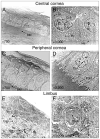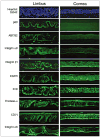Characterization of putative stem cell phenotype in human limbal epithelia
- PMID: 15153612
- PMCID: PMC2906385
- DOI: 10.1634/stemcells.22-3-355
Characterization of putative stem cell phenotype in human limbal epithelia
Abstract
This study evaluated proposed molecular markers related to stem cell (SC) properties with the intention of characterizing a putative SC phenotype in human limbal epithelia. Human corneal and limbal tissues were cut in the vertical and horizontal meridians for histology, transmission electron microscopy (TEM), and immunostaining. Semiquantitative reverse transcriptase-polymerase chain reaction (RT-PCR) and in situ hybridization were used to evaluate gene expression. TEM showed that the limbal basal cells were small primitive cells. Immunostaining disclosed that p63, ABCG2 and integrin alpha9 were primarily expressed by the basal epithelial cells of limbus. Antibodies against integrin beta1, epidermal growth factor receptor (EGFR), K19, enolase-alpha, and CD71 stained the basal cells of the limbus more brightly than the suprabasal epithelia. Integrin alpha6, nestin, E-cadherin and connexin 43 did not stain the limbal basal cells, but the suprabasal epithelia of the cornea and limbus showed strong immunoreactivity. K3 and involucrin stained only corneal and limbal superficial cells. RT-PCR showed higher levels of p63, ABCG2 and integrin alpha9 mRNA, but lower levels of K3, K12 and connexin 43 expressed in the limbal epithelia than the corneal epithelia. In situ hybridization showed that p63 transcripts were located in basal layer of the limbal epithelium. This work suggests that the basal epithelial cells of the limbus are p63, ABCG2 and integrin alpha9 positive, and nestin, E-cadherin, connexin 43, involucrin, K3, and K12 negative, with relatively higher expression of integrin beta1, EGFR, K19, and enolase-alpha. This putative SC phenotype may facilitate the identification and isolation of limbal epithelial SCs.
Figures







References
-
- Hall PA, Watt FM. Stem cells: the generation and maintenance of cellular diversity. Development. 1989;106:619–633. - PubMed
-
- Potten CS, Loeffler M. Stem cells: attributes, cycles, spirals, pitfalls and uncertainties. Lessons for and from the crypt. Development. 1990;110:1001–1020. - PubMed
-
- Blau HM, Brazelton TR, Weimann JM. The evolving concept of a stem cell: entity or function? Cell. 2001;105:829–841. - PubMed
-
- Watt FM, Hogan BL. Out of Eden: stem cells and their niches. Science. 2000;287:1427–1430. - PubMed
Publication types
MeSH terms
Substances
Grants and funding
LinkOut - more resources
Full Text Sources
Other Literature Sources
Medical
Research Materials
Miscellaneous

